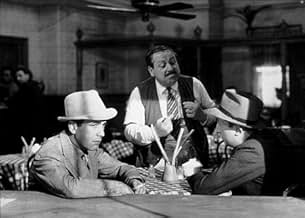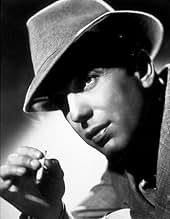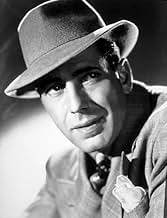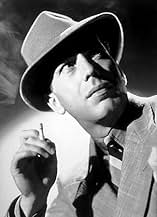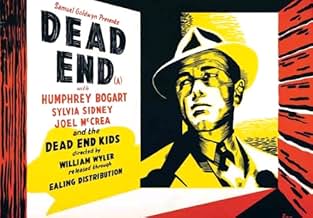VALUTAZIONE IMDb
7,2/10
9247
LA TUA VALUTAZIONE
Le vite di due giovani, un uomo e una donna, un famigerato gangster e un gruppo di ragazzi di strada, convergono un giorno in una baraccopoli di New York.Le vite di due giovani, un uomo e una donna, un famigerato gangster e un gruppo di ragazzi di strada, convergono un giorno in una baraccopoli di New York.Le vite di due giovani, un uomo e una donna, un famigerato gangster e un gruppo di ragazzi di strada, convergono un giorno in una baraccopoli di New York.
- Regia
- Sceneggiatura
- Star
- Candidato a 4 Oscar
- 1 vittoria e 4 candidature totali
Leo Gorcey
- Spit
- (as Leo B. Gorcey)
Recensioni in evidenza
It offers a vivid portrait of people caught up in a continual fight to somehow satisfy themselves despite the oppressive environment that seemed to quiet their every attempt
Joel McCrea is a frustrated architect who dreams of tearing down the slums and Sylvia Sidney portrays a shopgirl struggling for identity and meaning in her life, a life made even more complicated by having to look after her brother (Billy Halop). The boy idolizes the decadent Bogart, an excessive admiration shared by the rest of the Dead End Kids, here recreating their original Broadway roles with noisy good humor
Opposing these idealists is their real threat, Bogart, an assassin named Baby Face Martin Bogart is impolitely rejected by a mother (Marjorie Main) who hates him and an ex-girl friend (Claire Trevor) who leaves him bitter and disillusioned when he discovers that she has become a hooker
Rebuked by those he had been sentimental enough to want to visit, he rapidly reverts to represent beforehand and plans a kidnapping in order to rescue something from the consumed affair
"Dead End" remains one of Bogart's best films, where the actor proves that he is capable of handling difficult material with considerable skill
Joel McCrea is a frustrated architect who dreams of tearing down the slums and Sylvia Sidney portrays a shopgirl struggling for identity and meaning in her life, a life made even more complicated by having to look after her brother (Billy Halop). The boy idolizes the decadent Bogart, an excessive admiration shared by the rest of the Dead End Kids, here recreating their original Broadway roles with noisy good humor
Opposing these idealists is their real threat, Bogart, an assassin named Baby Face Martin Bogart is impolitely rejected by a mother (Marjorie Main) who hates him and an ex-girl friend (Claire Trevor) who leaves him bitter and disillusioned when he discovers that she has become a hooker
Rebuked by those he had been sentimental enough to want to visit, he rapidly reverts to represent beforehand and plans a kidnapping in order to rescue something from the consumed affair
"Dead End" remains one of Bogart's best films, where the actor proves that he is capable of handling difficult material with considerable skill
Now here's a fascinating world from the late 1930s, where they're not really angels but they still have faces dirty, where the rich butt up with poor, as they wander through their backdoor, and the disconnect provokes and displeases. The kids of the Dead End are always causing trouble, as they live their lives in a ghetto like bubble, observed by 'Baby Face' Martin, who's returned to be disheartened, this villain prefers knife over knuckle. You're left with a feeling that the worlds on the cusp, a self-destructive nature that might leave it in dust, but four years later a falcon will rise, and a year after that a white house will surprise.
This movie is not only a great story, it is a great social commentary on the divisions between rich and poor. The main story concerns the return of a gangster to his old neighborhood, but a couple of side stories concern the gang of kids who seemingly idolize the hood and the rich people who live in a luxury apartment that is next to the slum. This film could be made today because the conditions that are in the film still exist today only they are a hundred times worse because the gap between the rich and the poor in this country have widened even more. This film should be shown more on television
Brilliant adaptation of a hit Broadway play about life in the slums of New York during the Great Depression. A gangster on the run from the law returns to the neighborhood he grew up in to plot his next move. Add to that a little romance and a gang of street kids getting into trouble and you've got a first-rate Warner Bros. urban drama picture (only this wasn't made by Warners). Humphrey Bogart plays the gangster character 'Baby Face' Martin. In some ways it was a very familiar role to many others he'd played up to this point, but this one was a bit more layered and gave him a chance to flex his acting muscles some. Solid turns from Joel McCrea, Wendy Barrie, Claire Trevor, and Marjorie Main. Allen Jenkins is always fun to watch. Next to Bogart, I'd have to say the standout is the lovely Sylvia Sidney, one of my favorite actresses from this period. She had some of the most expressive eyes in the business.
Among other things, the film's notable for being the first screen appearance of the Dead End Kids, who would go on to appear in several WB gangster pictures (in basically the same roles as this) before starring in a few series of their own under different names, my favorite of which was the Bowery Boys. It's interesting to see them here looking and acting much more like roughneck teenagers than later where they were clearly adults behaving like overgrown kids. Directed by William Wyler, this is a "message movie" from a time when those types of movies actually felt earnest and not phony or preachy. Yes it's pretty much a filmed stage play, which was very common in the 1930s, but the great cast, excellent sets, and Gregg Toland's beautiful photography goes a long way to bringing it all to life. Not one you'll want to pass up if you're a fan of the stars or the period.
Among other things, the film's notable for being the first screen appearance of the Dead End Kids, who would go on to appear in several WB gangster pictures (in basically the same roles as this) before starring in a few series of their own under different names, my favorite of which was the Bowery Boys. It's interesting to see them here looking and acting much more like roughneck teenagers than later where they were clearly adults behaving like overgrown kids. Directed by William Wyler, this is a "message movie" from a time when those types of movies actually felt earnest and not phony or preachy. Yes it's pretty much a filmed stage play, which was very common in the 1930s, but the great cast, excellent sets, and Gregg Toland's beautiful photography goes a long way to bringing it all to life. Not one you'll want to pass up if you're a fan of the stars or the period.
The main credit of "Dead End" lies in the stunning visual beauties. The studio reproduction of a New York slum is really magnificent, worth of other major achievements of the same kind, like, say, the set of "Rear Window". A true joy for the eyes. The work of the camera and William Wyler's direction are outstanding, as well. And, of course, the job of the cast is great. Bogart, still in the role of the villain, McCrea and Sylvia Sidney are excellent, and save their rather straightforward characters and lines. In my opinion, the best one is Claire Trevor, in the small part of the lost girl. I normally dislike kids on the screen, but I must concede that here they give great performances, playing the gang of street-boys.
The story is conventional, with a noble message, but few and predictable twists. The script is often clumsy and preachy. Luckily enough, the director gives a quick pace to the narration and inserts a number of humoristic touches. There's a main flaw in the plot: I think that, even in the States of the 1930s, a common citizen couldn't freely shoot a gangster.
Anyway, I've found in the screen-play an interesting and modern theme, namely the psychological ambiguity of some characters, whom even the all-knowing viewer cannot fully understand. For instance, Claire Trevor is apparently the cliche disgraced girl, the innocent victim of poverty, lack of opportunities, social injustice. To end as a prostitute is her unavoidable doom... But, when her former boy-friend Bogie gives some money to help her, she makes the horribly vulgar request of "twenty more bucks"... with a grimace worth of a hardened prostitute (great stuff by Trevor!). So we see that, after all, perhaps that girl is not so innocent as she pretends to be... And what about Drina's brother, the leader of the street-boys? The audience is perfectly aware that, in spite of his whining, weeping self-apologies (when he's in dire straits), the boy is a REAL criminal. We see that he deliberately harms people, steals, brutally thrashes the rich kid, wants to slash his gang-mate. And he just mocks his affectionate sister and his friend McCrea when, in tears, he cries that he's good, that he didn't intend to harm, and all that. So, are we supposed to feel sympathy for this hideous boy? Interesting ambiguity, which creates a fine artistic effect... perhaps beyond the actual intentions of the writer Lillian Hellman.
All in all, we may forgive the defects of the movie. it is worth seeing "Dead End", enjoying the beauty of the set and the work of director and actors.
The story is conventional, with a noble message, but few and predictable twists. The script is often clumsy and preachy. Luckily enough, the director gives a quick pace to the narration and inserts a number of humoristic touches. There's a main flaw in the plot: I think that, even in the States of the 1930s, a common citizen couldn't freely shoot a gangster.
Anyway, I've found in the screen-play an interesting and modern theme, namely the psychological ambiguity of some characters, whom even the all-knowing viewer cannot fully understand. For instance, Claire Trevor is apparently the cliche disgraced girl, the innocent victim of poverty, lack of opportunities, social injustice. To end as a prostitute is her unavoidable doom... But, when her former boy-friend Bogie gives some money to help her, she makes the horribly vulgar request of "twenty more bucks"... with a grimace worth of a hardened prostitute (great stuff by Trevor!). So we see that, after all, perhaps that girl is not so innocent as she pretends to be... And what about Drina's brother, the leader of the street-boys? The audience is perfectly aware that, in spite of his whining, weeping self-apologies (when he's in dire straits), the boy is a REAL criminal. We see that he deliberately harms people, steals, brutally thrashes the rich kid, wants to slash his gang-mate. And he just mocks his affectionate sister and his friend McCrea when, in tears, he cries that he's good, that he didn't intend to harm, and all that. So, are we supposed to feel sympathy for this hideous boy? Interesting ambiguity, which creates a fine artistic effect... perhaps beyond the actual intentions of the writer Lillian Hellman.
All in all, we may forgive the defects of the movie. it is worth seeing "Dead End", enjoying the beauty of the set and the work of director and actors.
Lo sapevi?
- QuizWilliam Wyler gave Claire Trevor an old purse and broken high heel shoes. He had her minimize her make-up and ordered her not to comb her hair when she got up in the morning. He wanted her to look like the downtrodden character she was playing.
- BlooperBaby Face Martin suddenly appears from nowhere and is leaning against a railing as the boys are fighting.
- Curiosità sui creditiOpening credits prologue: Every street in New York ends in a river. For many years the dirty banks of the East River were lined with the tenements of the poor. Then the rich, discovering that the river traffic was picturesque, moved their houses eastward. And now the terraces of these great apartment houses look down into the windows of the tenement poor.
- ConnessioniFeatured in AFI Life Achievement Award: A Tribute to William Wyler (1976)
- Colonne sonoreBoo-Hoo
(1937) (uncredited)
Music by Carmen Lombardo and John Jacob Loeb
Lyrics by Edward Heyman
Played at the upstairs party and sung by Huntz Hall in the street
I più visti
Accedi per valutare e creare un elenco di titoli salvati per ottenere consigli personalizzati
- How long is Dead End?Powered by Alexa
- When did the film open in Chicago?
Dettagli
Botteghino
- Budget
- 300.000 USD (previsto)
- Tempo di esecuzione1 ora 33 minuti
- Colore
- Proporzioni
- 1.37 : 1
Contribuisci a questa pagina
Suggerisci una modifica o aggiungi i contenuti mancanti

Divario superiore
By what name was Strada sbarrata (1937) officially released in India in English?
Rispondi


